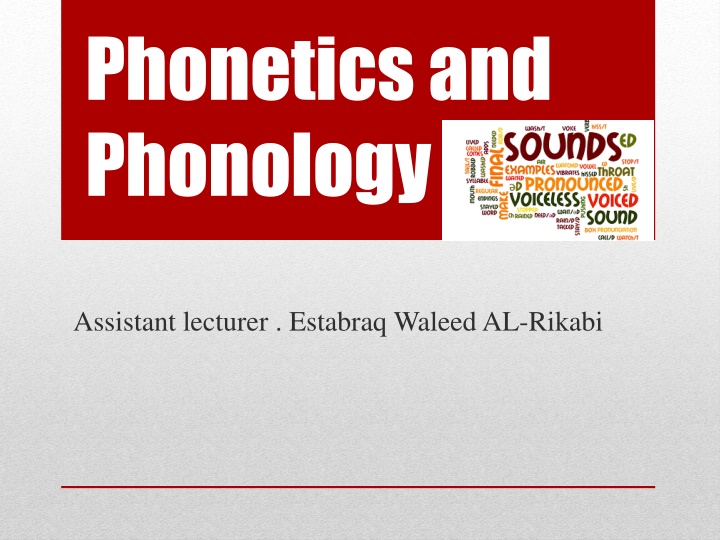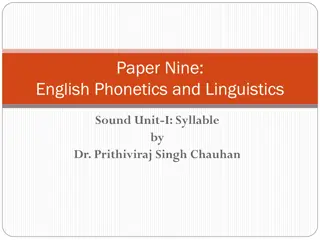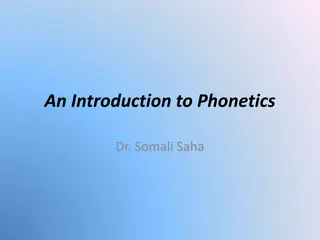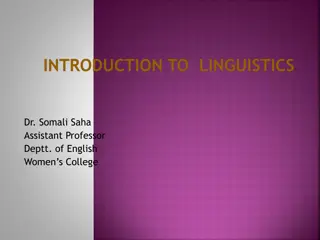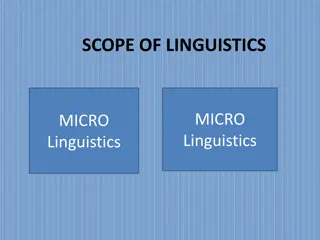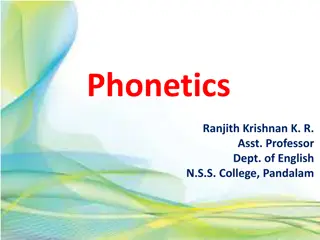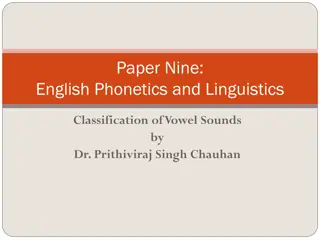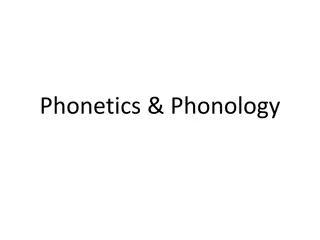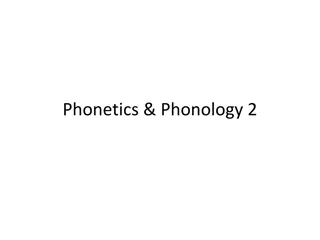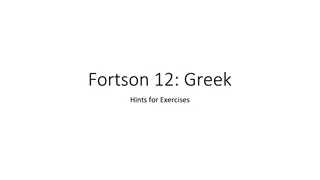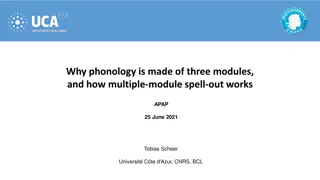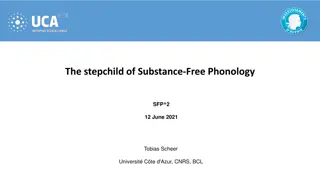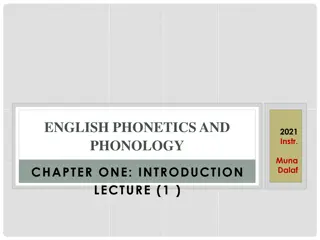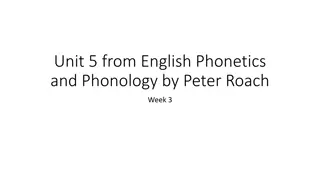Introduction to Phonetics and Phonology
This content provides insights into Phonetics and Phonology, covering the scientific study of speech sounds, their production, and their functions in language. It explores phonemes, allophones, syllables, intonation, and stresses, along with the importance of phonetic transcription and distinct phonemic systems among languages.
Download Presentation

Please find below an Image/Link to download the presentation.
The content on the website is provided AS IS for your information and personal use only. It may not be sold, licensed, or shared on other websites without obtaining consent from the author.If you encounter any issues during the download, it is possible that the publisher has removed the file from their server.
You are allowed to download the files provided on this website for personal or commercial use, subject to the condition that they are used lawfully. All files are the property of their respective owners.
The content on the website is provided AS IS for your information and personal use only. It may not be sold, licensed, or shared on other websites without obtaining consent from the author.
E N D
Presentation Transcript
Phonetics and Phonology Assistant lecturer . Estabraq Waleed AL-Rikabi
Phonetics: is the scientific study of speech sounds.it concerned with how sounds are produced; transmitted and perceived we will only look at the production of sounds. its a natural science that deals with human speech sounds in general without reference to any particular language. Phonology: is a branch of linguistics that refers to the scientific study of the system sounds used in particular language or in language in general . or pattern of speech
Phonology Phonetics 1. Phonology is concerned with how sounds function in relation to each other in a language. For example: Phonemes, Allophones, Syllable, Intonation and Stress. 1. Is concerned with how sounds are produced, transmitted and perceived ( we will only look at the production of sounds). for example: Articulation, acoustics and auditory. 2. Descriptive linguistics . 3. Covers all speech sounds (universal ) . 4. Limited scope . 5. The study of the phonetics of a foreign language gives us a much better ability both to hear and to correct mistakes that we make, and also to teach pronunciation of the foreign language(in this case English) to others. 2. Theoretical linguistics . 3. Sounds of a particular language 4. Broader scope . 5. Phonology gives us insight into how the human mind works.
English pronunciation is also divided into two main accent groups, the rhotic and the non-rhotic, depending on when the phoneme /r/ is pronounced. Rhotic speakers pronounce written "r" in all positions. They will pronounce the "r" in stork, whereas non-rhotic speakers won't, making no distinction between stork and stalk. Non-rhotic speakers pronounce "r" only if it is followed by a vowel - right, rain, room, Robert, far away, etc.
The spoken language can be broken down into a string of sound units (phonemes) A phoneme is the smallest 'distinctive unit sound of a language, It distinguishes one word from another in a given language, This means changing a phoneme in a word, produces another word that has a different meaning. In the pair of words (minimal pairs) hat' and 'bat' the distinguishing sounds/h and by are both phonemes. (They capable making a difference in meaning of the word) . They are 44 sounds( phonemes)
Phoneme : is the smallest unit of phonology or the minimal unit in the sound system . The complete set of phonemes is called the ( phonemic system ) of the language . No two languages have the same phonemic system . Allophones : are different realizations of the same phoneme . For example , the aspirated / p / of pin and the unaspirated / p / of spin are allophones of the same phoneme /p / . Phonetic transcription: the representation of each phoneme by a single symbol. Play /plei/ F4 XGc 2 e
Comparison : Phonemes Allophones -Abstract sound types . 1. - Real speech sounds , 1. 2. - The number in a language is limited . 3. - It can change the meaning : " Ball - Call " '' Car - Cat '' realizations of speech . 2. - The number is unlimited . 3. - It cannot change the meaning . phoneme in
Voiceless Sounds : are the sounds that are produced when the vocal cords are open , the air can pass through them freely and therefore don't vibrate ./s , t, f/ Voiced Sounds : are the sounds that are produced when the vocal cords are gently held together, they vibrate as the air forces the vocal cords away then they close quickly and the process is repeated continuously . /z, d, v/
Letters and Sounds In writing, words are made of letters. In speech, words are made of sounds. These must never be in mixed up. Letters are written whereas sounds are spoken. Written letters cannot make us pronounce sounds which we already do not know; they remained us of corresponding sounds. As phonetics and phonology both deal with sounds, and as English spelling and English pronunciation are two very different things, it is important that you keep in mind that we are not interested in letters here, but in sounds.
English short vowels English has a large number of vowel sounds; the first ones to be examined are short vowels . Short vowels are only relatively short , they can have quite different lengths in different contexts. 1- / i / (example words: 'bit; 'pin, 'fish') it is more open nearer in to the center. The lips are slightly spread. 2- / e / (example words: 'bet, 'men, 'yes') This is a front vowel. The lips are slightly spread. 3- / / (example words: 'bat, 'man , 'gas') This vowel is front. The lips are slightly spread. 4- / ^ / (example words: 'cut, come, 'rush') This is a central vowel. The lip position is neutral. 5- / o / (example words: 'pot, 'gone 'cross') This vowel is not quite fully back . The lips are slightly rounded. 6- / u / (example words: 'put , pull , 'push') . The lips are rounded
English long vowels : English has five long vowels , they tend to be longer than the short vowels in similar contexts. The long vowels differ from short vowels in length and quality . Differences in quality occur because of ( differences in tongue shape and position , and lip position ) . The length mark is made of two dots ( : ) . Long vowels include : 1. / i: / This is a close front vowel .The lips are slightly spread . Example words : ( beat , mean , peace , heat ) / 3: / This is a mid- central vowel which is used in many English accents as a hesitation sound . The lip position is neutral . Example words : ( bird , fern , purse ) / a: / This is an open vowel . The lip position is neutral . Example words : ( card , half , pass , March ) / o: / This vowel is almost fully back and has quite string lip- rounding. Example words : ( board , torn , horse ) / u: / This is a close back vowel , and the lips are only moderately rounded . Example words : ( food , soon , loose , moon , spoon ) 2. 3. 4. 5.
Notes 1- we didn t make any transcription for each letter that we didn t pronounce it. 2-A capital letter is never written in phonemic transcription. 3- the phonemic transcription for these two letters (er) are Reader --- /ri:d / 4- if the letter (a) comes in the middle of the word and this word consist of three letters , the phonemic transcription for (a) will be ( ). Hat --- /h t/, car /c r/ 5- if (re) comes together in the beginning of the verb , the phonemic transcription will be /r / .. Reread /r ri:d/ . 6- call /k :l/ , center/sent / 7- a+ll --- the phonemic transcription will become / :/ --- ball/b :/ 8- the phonemic transcription for( aw) will be / :/-- saw/s :/ 9- (ar) if its comes in the middle of the word, the phonemic transcription will be / :/ --- card /k :d/ 10- (i) if its comes in the middle of the word and this word end with letter e , the phonemic transcription for letter I will become / /. Side/s d/ , fine/f n/.
1. (ew) if its comes in the end of the word, the phonemic transcription will be /ju:/. 2. Few /fju:/ , new /nju:/ , dew /dju:/ 3. (ir) (ur) if its comes in the middle of the wors, the phonemic transcription will be / :/ bird /b :d/ , purse /p :s/ 4. (oi) if its comes in the begging or middle of the word, the phonemic transcription will be / / , join / n/ , oil / l/ 5. (ure) if its comes in the end of the word, the phonemic transcription will be / / , lecture /lek / , picture /p k /. 6. Tu / / 7. (y) if its comes in the end of the word will pronunciation (long (i)). the phonemic transcription will be / / , fly /fl / , cry/kr / 8. (ay) if its comes in the end of the word, the phonemic transcription will be / / , play/pl / , pray/pr / 9. Qu /kw/ , quite/kw t/ 10. Sh / / , tion / n/ 11. (a) if its comes in the middle of the word and this word ended by letter e, the phonemic transcription will be / / , name/n m/.
Fall / f:l/ 1. /f/ Voice / v s/ 2. /v/ Thin / n/ 3. / / Consonants 4. / / Then / en/ 5. /s/ So / s / 6. /z/ Zoo /zu:/
She /i:/ 7. / / 8. / / Vision /v n/ 9. /p/ Pen /pen/ 10. /b/ Bad /b d/ 11. /t/ Tea / ti:/ Did /d d/ 12. /d/
Cat /kt/ 13. /k/ Got /g t/ 14. /g/ Chin / n/ 15./ / 16./ / Jug / g/ Man /m n/ 17./m/ no /n / 18./n/
Sing /s/ 19./ / 20./j/ Yes /jes/ Wet /wet/ 21./w/ 22. /r/ Red /red/ 23. /l/ Leg /leg/ how /h / 24./h/
See /si:/ 1./i: / 2./ / Sit /s t/ 3./ / Ten /ten/ Vowels 4./ / Hat /h t/ Arm / :m/ 5./ :/ 6./ / got /g t/
Saw /s:/ 7./ :/ 8./ / Put /p t/ 9./u:/ Too /tu:/ 10./ / Cup /k p/ Fur /f :/ ,bird /b :d/ 11./ :/ ago / g / 12./ /
Go /g/ 13./ / Now /n / 14./ / Diphthongs: it two sounds comes Take /t k/ 15./ / Consonants together and its product a new sounds 16./ / Five /f v/ Boy /b / 17./ / near /n / 18./ /
Hair /h/ 19./ / Poor /p / 20./ /
